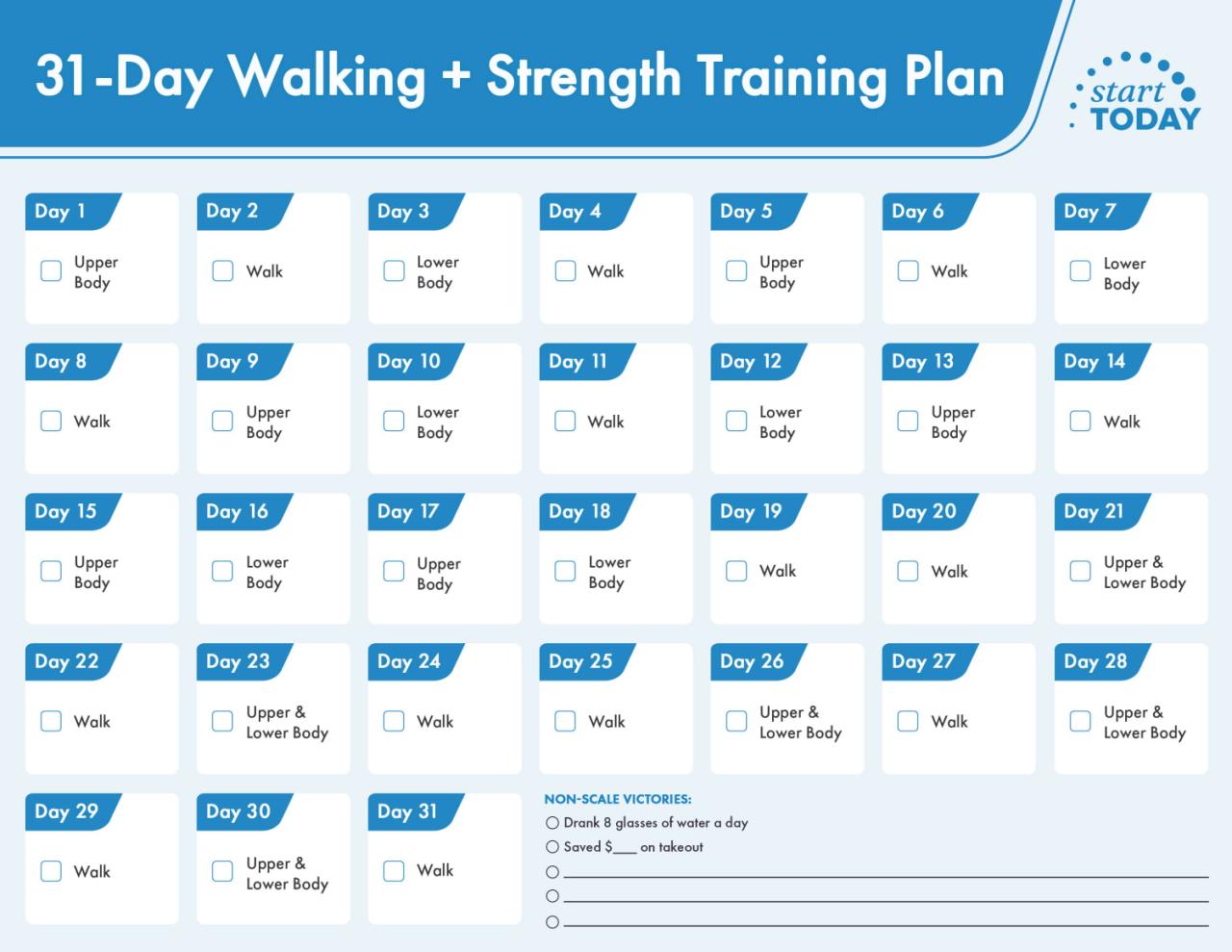Beginner Weight Training Programs for Strength and Muscle Gain: Forget the flabby! This isn’t your grandpa’s weightlifting – we’re talking about sculpting a physique worthy of a Greek god (or goddess!), all while avoiding the pitfalls of poorly planned workouts and questionable gym etiquette. We’ll guide you through building a program that’s as effective as it is enjoyable, transforming your body and your confidence in the process.
Get ready to ditch the excuses and embrace the iron!
This guide covers everything from crafting a personalized 8-week plan to mastering fundamental exercises, fueling your gains with the right nutrition, and navigating the inevitable bumps in the road. We’ll arm you with the knowledge and motivation to achieve your fitness goals, one rep at a time. Think of us as your personal cheerleaders, but with a slightly more scientific approach.
Introduction to Beginner Weight Training
So, you’re thinking about joining the iron-pumping, muscle-building masses? Fantastic! Weight training isn’t just for bodybuilders; it’s a fantastic way to boost your overall health, fitness, and even your mood. Forget the images of sweaty giants grunting under impossible weights – this is about
you* starting a journey to a stronger, healthier version of yourself.
Weight training offers a plethora of benefits for beginners. You’ll notice improvements in strength and endurance, naturally. But beyond that, you’ll likely see a boost in your metabolism, leading to easier weight management. Bone density increases, reducing the risk of osteoporosis later in life. And let’s not forget the mental benefits: weight training can be incredibly stress-relieving and confidence-building.
It’s a powerful tool for both physical and mental well-being.
Proper Form and Technique in Weight Training
Proper form is absolutely paramount. Think of it like this: a poorly executed lift is like a poorly written sentence – it might get the general idea across, but it’s clumsy, inefficient, and risks causing significant damage. With weights, that damage could range from minor muscle strains to serious injuries. Mastering proper form ensures you’re working the intended muscles effectively and minimizing the risk of injury.
Start with lighter weights to focus on perfecting your technique before increasing the load. Consider working with a trainer initially to learn the correct movements for various exercises. Videos and detailed instructions are also valuable resources, but nothing beats personalized guidance.
Essential Safety Precautions for Beginners
Safety should always be your top priority. Before you even think about touching a dumbbell, make sure you’ve warmed up properly. A dynamic warm-up, like arm circles, leg swings, and torso twists, prepares your muscles for the workout ahead. Always start with lighter weights than you think you need; it’s far better to gradually increase the weight as your strength improves than to risk injury by pushing yourself too hard too soon.
Listen to your body; pain is a warning sign – stop the exercise and rest. Don’t be afraid to ask for help from experienced lifters or trainers; they can offer valuable advice and spot you during exercises. Finally, ensure your workout area is free from obstacles to prevent trips and falls. A safe and well-planned workout is a successful workout.
Designing a Beginner Program
So, you’re ready to sculpt yourself into a magnificent specimen of human strength? Fantastic! But before you leap into a world of iron and sweat, let’s craft a weight training plan that’s as smart as it is strong. We’ll avoid the “bro science” and focus on building a solid foundation for long-term success. Think of this as the architectural blueprint for your new, muscular physique.Designing a beginner weight training program requires careful consideration of several crucial factors.
Ignoring these can lead to injury, frustration, and a premature retreat back to the couch (which, let’s be honest, is a tempting option). But we’re going further than the couch, my friend! We’re building a better you.
Goal Setting and Experience Level
Your goals significantly influence your program’s design. Are you aiming for overall strength, muscle growth, or a combination of both? A powerlifter’s program will differ drastically from a bodybuilder’s. Similarly, your experience level dictates the intensity and volume you can safely handle. A complete newbie needs a gentler introduction than someone with prior fitness experience (even if that experience involved a questionable relationship with a treadmill).
Start slow and steady; Rome wasn’t built in a day, and neither is a superhero physique.
Available Equipment and Program Structure
The equipment available to you (gym membership, home gym, or just your own bodyweight) will dictate the exercises you can perform. A home workout will differ from a gym-based program. A well-structured program typically involves full-body workouts initially, gradually progressing to more split routines (e.g., upper body/lower body splits) as strength and endurance improve. This allows for balanced muscle development and prevents overtraining.
Remember, consistency is key; a perfectly designed program is useless if you don’t stick to it.
Sample 8-Week Beginner Weight Training Program (3 Workouts Per Week)
This program focuses on compound exercises (movements that work multiple muscle groups simultaneously) to maximize efficiency and overall strength gains. Remember to choose weights that challenge you without compromising proper form.
| Day | Exercise | Sets | Reps |
|---|---|---|---|
| Monday | Squats | 3 | 8-12 |
| Monday | Bench Press | 3 | 8-12 |
| Monday | Bent-Over Rows | 3 | 8-12 |
| Wednesday | Deadlifts | 1 | 5 |
| Wednesday | Overhead Press | 3 | 8-12 |
| Wednesday | Pull-ups (or Lat Pulldowns) | 3 | As many reps as possible (AMRAP) |
| Friday | Squats | 3 | 8-12 |
| Friday | Bench Press | 3 | 8-12 |
| Friday | Bent-Over Rows | 3 | 8-12 |
Note: This is a sample program. Adjust weights and reps based on your individual capabilities. Focus on maintaining good form throughout each exercise.
Progressive Overload: The Key to Growth
Progressive overload is the cornerstone of any successful strength training program. It simply means gradually increasing the demands placed on your muscles over time. This could involve increasing the weight, reps, sets, or decreasing rest time between sets. Without progressive overload, your muscles will adapt to the current stimulus and stop growing. Think of it like this: if you always lift the same weight, your muscles will say, “Been there, lifted that,” and refuse to cooperate further.
To continuously challenge your muscles, you must consistently push your limits, but safely! A gradual increase in weight by 2.5-5 pounds is usually a safe bet. Listen to your body, and don’t push yourself too hard, too fast.
Essential Exercises for Strength and Muscle Gain
So, you’re ready to sculpt your physique like Michelangelo sculpted David (minus the whole naked-in-a-museum thing)? Fantastic! But before you start chucking around weights like a pro wrestler at a pancake breakfast, let’s lay down some foundational exercises. These are the bedrock of any successful strength and muscle-building program, providing a solid base for future gains. We’ll focus on compound movements – exercises that work multiple muscle groups simultaneously – because efficiency is key when you’re aiming for maximum impact with minimal time commitment.
Think of them as the all-you-can-eat buffet of muscle building.These exercises, while seemingly simple, require precise form to prevent injuries and maximize results. Think of it as learning to drive a stick shift – initially clunky, but once mastered, it’s incredibly rewarding. We’ll break down the proper technique for each, ensuring you build strength and muscle safely and effectively.
Squats
The squat is the king of lower-body exercises. It primarily targets the quadriceps, hamstrings, and glutes, but also engages your core for stability. Imagine yourself sitting down in a chair without actually using a chair. Start with your feet shoulder-width apart, toes slightly pointed outwards. Lower your hips as if sitting back into a chair, keeping your back straight and chest up.
Your knees should track over your toes, avoiding excessive inward or outward movement. The depth of your squat should be comfortable; aim for your thighs to be parallel to the ground, or slightly below if you’re feeling ambitious. To come back up, drive through your heels, engaging your glutes.Variations include front squats (barbell across the front of your shoulders), goblet squats (holding a dumbbell or kettlebell close to your chest), and sumo squats (feet wider than shoulder-width apart, toes pointed outwards).
Front squats emphasize the quads, while sumo squats target the inner thighs and glutes. Goblet squats are a great beginner variation as they improve posture and stability.
Bench Press
This classic upper-body exercise targets the chest, shoulders, and triceps. Lie on a bench with your feet flat on the floor, gripping the barbell slightly wider than shoulder-width apart. Lower the bar slowly to your chest, touching it lightly. Pause, then push the bar back up to the starting position, squeezing your chest at the top. Maintain a stable core throughout the movement, preventing your lower back from arching excessively.Variations include incline bench press (working the upper chest), decline bench press (emphasizing the lower chest), and dumbbell bench press (allowing for a greater range of motion and improved muscle activation).
Dumbbell variations are generally considered easier for beginners to maintain good form.
So you’re ready to ditch the flabby and embrace the buff? Beginner weight training programs for strength and muscle gain are your ticket to awesome, but finding the right one can be a workout in itself! That’s where checking out the best strength training program resources can really help you get started. Once you’ve found a solid foundation, you’ll be lifting like a boss in no time, building those muscles and feeling the strength! Remember, consistency is key with beginner weight training programs.
Deadlifts
The deadlift is a full-body powerhouse exercise, working your back, hamstrings, glutes, and forearms. Stand with your feet hip-width apart, with the barbell positioned in front of you. Bend down and grip the bar with an overhand or mixed grip (one hand overhand, one underhand). Keeping your back straight and core engaged, lift the bar by extending your hips and knees simultaneously.
Maintain a neutral spine throughout the movement, avoiding rounding your back. Lower the bar back to the ground with control.Variations include Romanian deadlifts (emphasizing the hamstrings), sumo deadlifts (similar to sumo squats, targeting the inner thighs and glutes), and trap bar deadlifts (a more beginner-friendly variation due to its reduced spinal stress).
Overhead Press
This exercise targets the shoulders, triceps, and upper back. Stand with your feet shoulder-width apart, holding a barbell or dumbbells at shoulder height. Press the weight straight overhead, extending your arms fully. Slowly lower the weight back to the starting position, controlling the descent. Maintain a stable core throughout the movement, avoiding leaning back excessively.Variations include seated overhead press (providing greater stability), Arnold press (rotating the wrists as you press), and dumbbell overhead press (allowing for a greater range of motion).
Pull-ups
This challenging exercise primarily works the back muscles (latissimus dorsi), biceps, and forearms. Grip the pull-up bar with an overhand grip, slightly wider than shoulder-width apart. Hang with your arms fully extended. Pull yourself up until your chin clears the bar. Slowly lower yourself back down to the starting position.
If you can’t perform a full pull-up, start with assisted pull-ups using resistance bands or a machine.Variations include chin-ups (underhand grip, emphasizing the biceps), wide-grip pull-ups (working the lats more), and close-grip pull-ups (targeting the biceps and forearms).
Rows
Rows are essential for building a strong back. They primarily target the back muscles (latissimus dorsi, rhomboids, trapezius), biceps, and forearms. There are various row variations, including barbell rows, dumbbell rows, and cable rows. Regardless of the variation, the basic movement involves pulling a weight towards your chest while maintaining a straight back.Variations include bent-over rows (using a barbell), dumbbell rows (allowing for a greater range of motion), and seated cable rows (providing greater stability).
Dips
Dips are a bodyweight exercise that primarily targets the chest, shoulders, and triceps. They can be performed using parallel bars or a dip station. Position yourself with your hands gripping the bars, and lower your body by bending your elbows until your upper arms are parallel to the floor. Push back up to the starting position. Variations include close-grip dips (emphasizing the triceps) and wide-grip dips (targeting the chest more).
You can adjust the difficulty by adding weight or using a chair for assisted dips.
Nutrition for Muscle Growth and Recovery
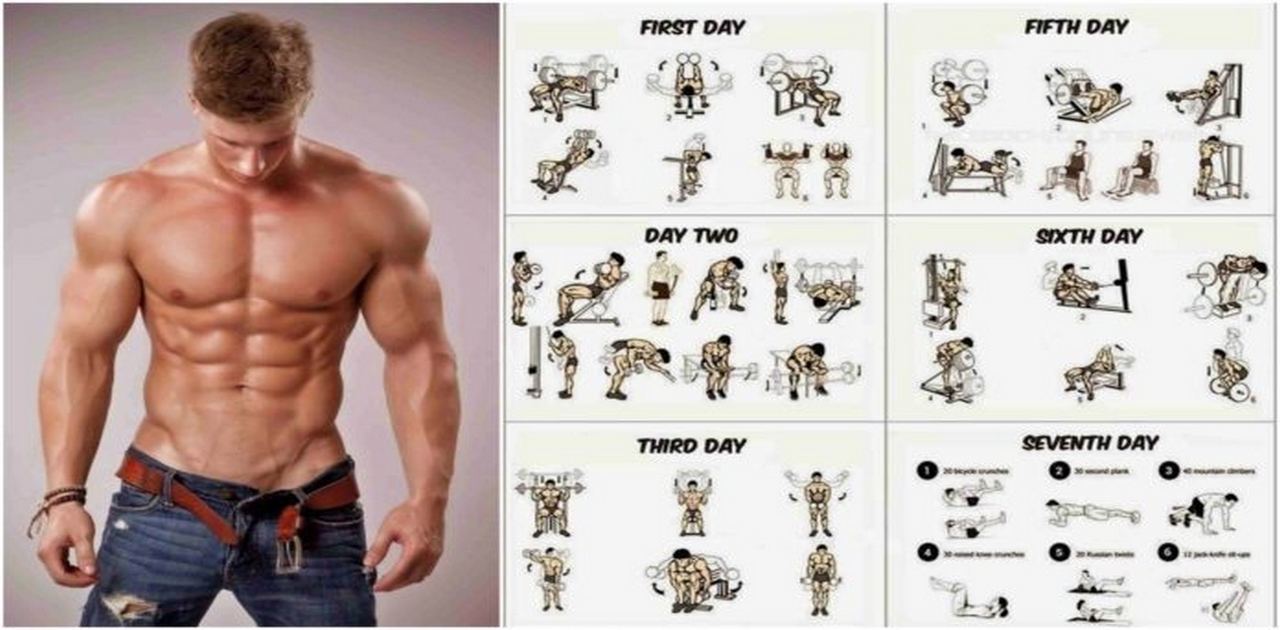
Fueling your body for a weight training program is like fueling a race car – you wouldn’t put regular gas in a Formula 1, would you? Proper nutrition is crucial for building muscle, recovering effectively, and avoiding those pesky injuries that can sideline your gains. Think of food as your body’s building blocks and recovery fuel. Without the right ingredients, your muscles won’t grow, and you’ll be constantly battling fatigue.Proper nutrition plays a vital role in muscle growth and recovery after weight training.
It’s not just about eating more; it’s about eating the
- right* things at the
- right* times. Consuming enough calories to support your training and recovery is paramount, but the quality of those calories is just as important.
Sample Meal Plan for Muscle Growth and Recovery
A sample meal plan needs to be tailored to individual needs, activity levels, and caloric requirements. However, this plan offers a basic framework, emphasizing protein, carbohydrates, and healthy fats. Remember to adjust portion sizes based on your own needs and consult a nutritionist or registered dietitian for personalized guidance.
- Breakfast (7:00 AM): Oatmeal with berries and a scoop of whey protein powder. This provides sustained energy and protein for muscle repair.
- Mid-Morning Snack (10:00 AM): Greek yogurt with a handful of almonds. A great source of protein and healthy fats.
- Lunch (1:00 PM): Chicken breast salad sandwich on whole-wheat bread with a side of mixed greens. Lean protein and complex carbohydrates for sustained energy.
- Afternoon Snack (4:00 PM): A protein shake with banana. A quick and easy way to replenish protein and carbohydrates after your workout.
- Dinner (7:00 PM): Salmon with brown rice and steamed broccoli. Lean protein, complex carbohydrates, and healthy fats for optimal recovery.
- Before Bed Snack (Optional): Casein protein shake. This slow-digesting protein helps support muscle repair overnight.
Protein Intake for Muscle Growth
Protein is the king of muscle building. It provides the amino acids your body needs to repair and build new muscle tissue after your intense workouts. Think of it as the Lego bricks your body uses to construct bigger, stronger muscles. Aim for a daily protein intake of approximately 1.6 to 2.2 grams per kilogram of body weight.
- Examples of Protein-Rich Foods: Chicken breast, fish (salmon, tuna), lean beef, eggs, Greek yogurt, lentils, beans, tofu, and protein powders.
The Role of Carbohydrates and Fats in Weight Training
Carbohydrates are your body’s primary energy source, especially important for fueling your workouts. Choose complex carbohydrates like whole grains, fruits, and vegetables over simple sugars. Fats, often unfairly demonized, are essential for hormone production, nutrient absorption, and overall health. Focus on healthy fats found in avocados, nuts, seeds, and olive oil.
- Healthy Carbohydrate Choices: Brown rice, quinoa, oats, sweet potatoes, fruits, and vegetables.
- Healthy Fat Choices: Avocados, nuts (almonds, walnuts), seeds (chia, flax), olive oil, and fatty fish.
Rest and Recovery Strategies
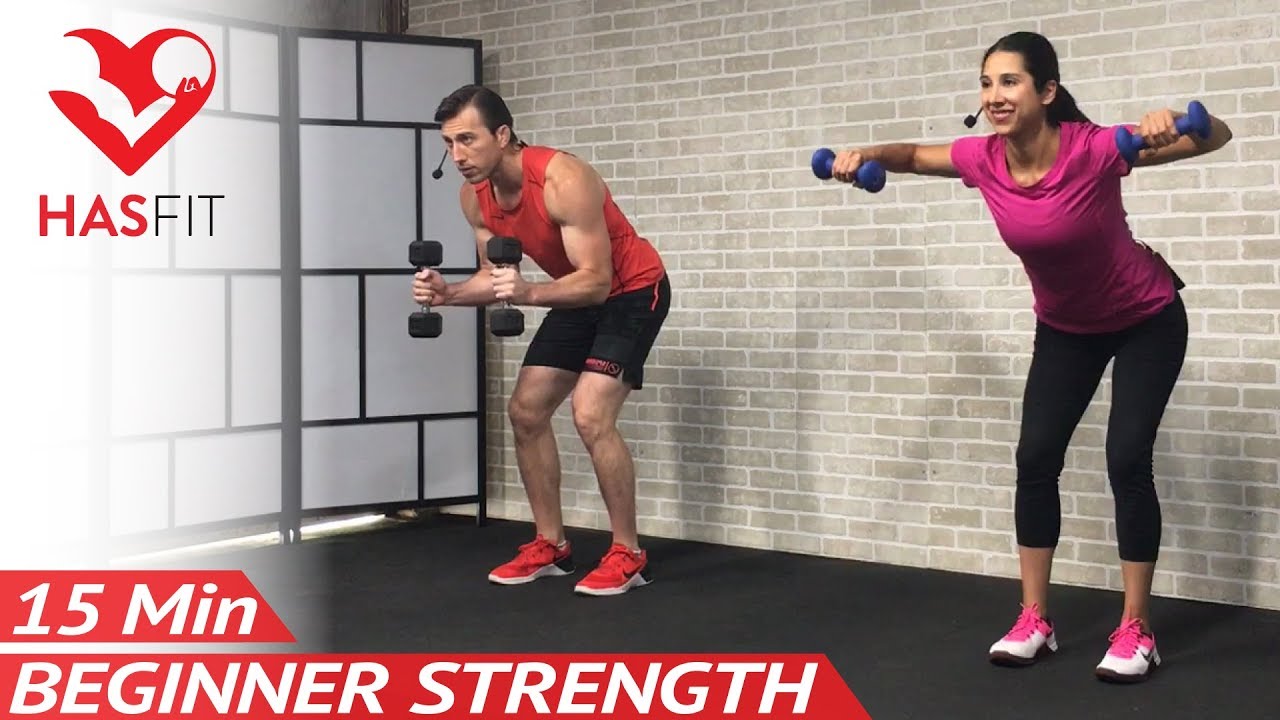
Think of your muscles like a finely-tuned sports car – pushing them hard is great, but without proper maintenance, they’ll sputter and stall. Rest and recovery aren’t just optional extras in your weight training journey; they’re the high-octane fuel that powers your gains. Ignoring this crucial element is like trying to win a marathon on a tricycle – you might get a little way, but you won’t be setting any records.Adequate rest and sleep are absolutely vital for muscle recovery and growth.
During sleep, your body releases hormones that promote muscle repair and growth, like human growth hormone (HGH). Skipping sleep is like telling your body to sabotage its own progress; you’ll hinder your strength gains and increase your risk of injury. Aim for 7-9 hours of quality sleep each night – your muscles will thank you for it.
Think of it as your body’s nightly muscle-building factory, churning out gains while you snooze.
Recovery Methods
Several effective methods can help your body bounce back from tough workouts. These aren’t just for the elite athletes; they’re simple strategies anyone can implement to improve their recovery and prevent soreness.
Stretching: Gentle stretching after your workouts increases blood flow to your muscles, helping to flush out metabolic waste products and reduce muscle stiffness. Think of it as a mini-massage for your muscles, helping them relax and prepare for the next workout. Focus on holding each stretch for 20-30 seconds, aiming for major muscle groups like your quads, hamstrings, and chest.
Foam Rolling: This self-massage technique targets muscle knots and tight areas, improving flexibility and reducing pain. Picture it as a deep tissue massage you can administer yourself – it might feel a little uncomfortable initially, but the relief is worth it. Roll slowly over the affected area, focusing on pressure points and areas of tightness. Spend 30-60 seconds per muscle group.
Active Recovery: This involves low-intensity activities like walking, swimming, or cycling, which promote blood flow without stressing your muscles further. It’s like giving your muscles a light jog instead of a full-on sprint – keeping them active but allowing them to recover. A leisurely 30-minute walk after a leg day can work wonders.
Sample Weekly Schedule
Consistency is key, so aim for a schedule that you can realistically stick to. This example shows a balanced approach, incorporating rest and active recovery:
| Day | Workout | Recovery |
|---|---|---|
| Monday | Upper Body Strength Training | Light stretching |
| Tuesday | Lower Body Strength Training | Foam rolling |
| Wednesday | Rest | 30-minute walk |
| Thursday | Upper Body Strength Training | Light stretching |
| Friday | Lower Body Strength Training | Foam rolling |
| Saturday | Rest | Active recovery (swimming or cycling) |
| Sunday | Rest | Relaxation and sleep |
Remember, this is just a sample – adjust it based on your own needs and recovery capacity. Listen to your body, and don’t hesitate to add extra rest days if you feel excessively sore or fatigued. Your body is a complex machine; treat it with the respect it deserves, and you’ll see the rewards in your progress.
Tracking Progress and Making Adjustments
So, you’ve bravely embarked on your weightlifting journey, conquering dumbbells and barbells like a tiny, yet determined, Hercules. But lifting heavy things isn’t just about brute force; it’s about smart progress. This section is your guide to tracking your gains (and losses – let’s be real, some days are tougher than others!) and making sure your training stays effective and enjoyable.Tracking your progress is like having a super-powered weightlifting sidekick – it gives you invaluable insight into what’s working and what needs tweaking.
Without it, you’re essentially lifting in the dark, hoping for the best. Think of it as a personal weightlifting detective, uncovering clues to your strength and muscle growth.
Tracking Progress with a Logbook or App
A simple logbook or a dedicated fitness app can be your best friend in this endeavor. It doesn’t need to be fancy; a notebook and pen will do the trick if you’re old-school. The key is consistency. Below is an example of a simple log you can adapt. Remember, even the smallest victories deserve to be celebrated!
| Date | Exercise | Weight (kg) | Reps |
|---|---|---|---|
| 2024-10-27 | Squats | 60 | 8 |
| 2024-10-27 | Bench Press | 40 | 10 |
| 2024-10-28 | Deadlifts | 80 | 5 |
| 2024-10-28 | Overhead Press | 30 | 12 |
Adjusting the Program Based on Progress and Limitations
Once you have a few weeks of data, look for trends. Are you consistently increasing the weight you lift? Are you hitting your rep goals? If yes, congratulations! You’re making progress. You can increase the weight slightly, add more reps, or even introduce a more challenging variation of the exercise.
If not, don’t despair! This is where adjustments come in. Perhaps you need to reduce the weight slightly to maintain good form, increase your rest periods, or focus on perfecting your technique. Listen to your body; it’s your wisest advisor in this journey.
Overcoming Plateaus and Maintaining Motivation
Hitting a plateau is a normal part of the weightlifting process. It doesn’t mean you’ve failed; it just means your body has adapted to your current training. To break through, try these strategies:
“A plateau is not a stopping point; it’s a challenging opportunity to grow stronger.”
Consider changing your workout routine, incorporating new exercises, or adjusting your sets and reps. You could also focus on improving your form to unlock more potential. Remember, consistency is key! Even small improvements are still progress. To maintain motivation, find a workout buddy, set realistic goals, reward yourself for milestones (not with a giant pizza, though!), and remember why you started in the first place.
Common Mistakes to Avoid
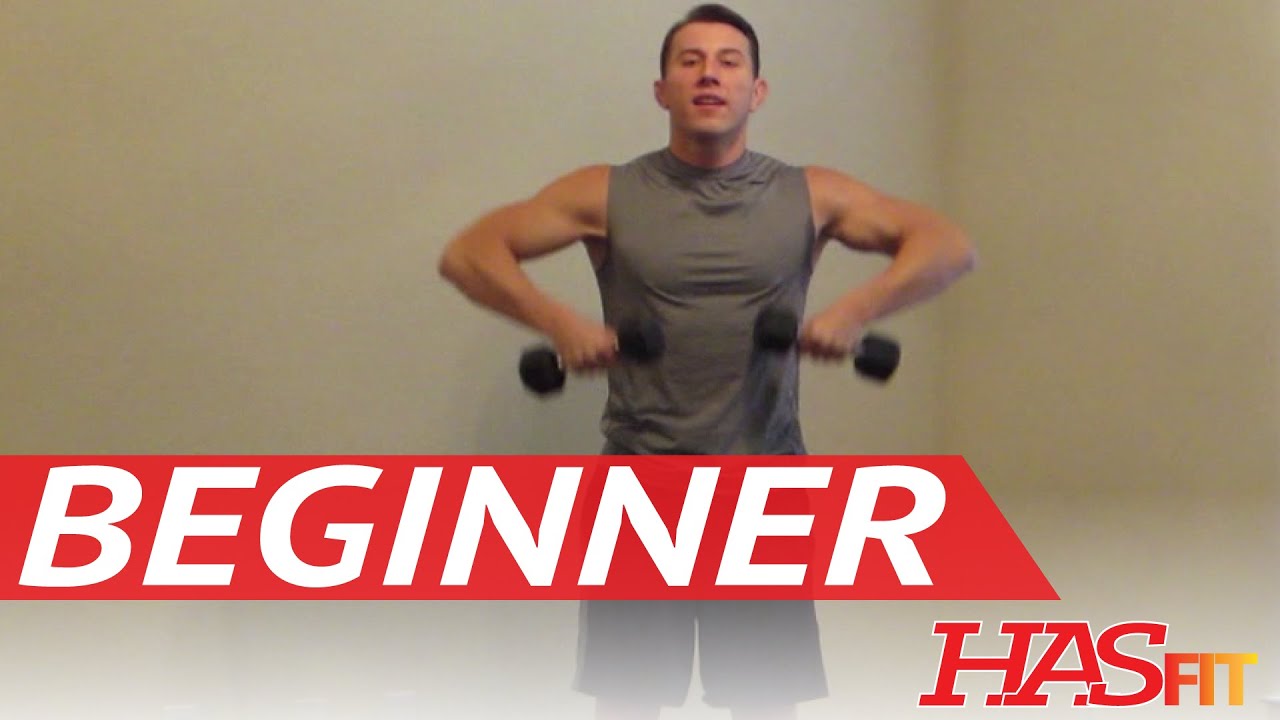
So, you’ve decided to embark on the glorious journey of weight training – congratulations! But beware, young Padawan, the path to muscle-bound magnificence is littered with pitfalls. Avoid these common beginner blunders, and you’ll be well on your way to achieving your fitness goals. Ignoring them, however, could lead to frustration, injury, and a serious case of “I should have listened.”Ignoring proper form is a recipe for disaster, both in terms of results and potential injuries.
This section will highlight some frequent missteps and offer solutions to ensure a safe and effective workout.
Improper Lifting Technique
Using incorrect form is like trying to build a house with wonky bricks – it’s not going to stand the test of time (or weight!). Poor form not only limits your muscle growth and strength gains but significantly increases your risk of injury. Imagine attempting a squat with your back rounded – ouch! That’s a fast track to a pulled muscle or worse.
Instead of focusing on lifting heavy weight, concentrate on performing each repetition with perfect form. Start with lighter weights and focus on mastering the movement pattern before gradually increasing the load.
Lifting Too Much Weight Too Soon
This is a classic beginner mistake – the ego lift. Wanting to impress others or yourself by lifting heavier weights than your body is ready for often leads to injury. Remember, progress is a marathon, not a sprint. It’s far better to start with weights you can comfortably handle with good form and gradually increase the weight as you get stronger.
Think of it like this: would you run a marathon on your first day of training? Probably not.
Neglecting Rest and Recovery
Your muscles don’t grow in the gym; they grow during rest. Skipping rest days or not getting enough sleep hinders muscle recovery and growth. Overtraining leads to burnout, injuries, and a plateau in your progress. Think of your muscles like a sponge – you need to allow them time to absorb the nutrients and rebuild after a workout.
Adequate rest is crucial for optimal results. Remember, even superheroes need their downtime!
Inconsistent Training
Consistency is key when it comes to weight training. Sporadic workouts won’t yield significant results. It’s better to have a regular, consistent workout routine, even if it means shorter sessions, than to sporadically hit the gym with intense, infrequent sessions. Imagine trying to build a sandcastle one grain at a time, then abandoning it for a week, only to return and start again – it’ll never be finished.
Ignoring Nutrition
Weight training without proper nutrition is like trying to build a house without bricks. You need the right fuel to support muscle growth and recovery. A balanced diet rich in protein, carbohydrates, and healthy fats is essential. Neglecting nutrition will severely limit your progress, no matter how hard you train. Consider consulting a nutritionist or dietician for personalized guidance.
Seeking Professional Guidance
So, you’ve bravely embarked on your weightlifting journey, armed with newfound knowledge and a burning desire to sculpt yourself into a magnificent specimen of human strength. But even the most meticulously planned solo mission can benefit from a seasoned guide, especially when navigating the complex world of weights and gains. Think of it like this: would you attempt brain surgery after watching a YouTube tutorial?
Probably not. Similarly, professional guidance can significantly enhance your fitness progress and minimize the risk of injury.Working with a certified personal trainer offers a multitude of advantages beyond simply having someone spot you on the bench press (though that’s a pretty great perk!). A qualified trainer can personalize a program tailored to your specific needs, goals, and limitations, ensuring you’re working efficiently and effectively.
They can correct your form, preventing potentially harmful habits that could lead to injury, and provide motivation and accountability when your willpower starts to wane (because let’s face it, we all have those days). They’re essentially your fitness sherpa, guiding you safely and effectively towards your peak performance.
Benefits of Working with a Certified Personal Trainer, Beginner weight training programs for strength and muscle gain
A certified personal trainer provides a wealth of benefits. They create a customized workout plan, considering individual fitness levels, goals, and any physical limitations. This personalized approach maximizes results and minimizes the risk of injury. Furthermore, trainers offer expert guidance on proper form and technique, preventing bad habits that can hinder progress or cause injury. Beyond the physical aspects, they also provide motivational support and accountability, helping individuals stay consistent with their fitness goals.
This support is invaluable, particularly during challenging periods. Finally, they offer valuable insights into nutrition and recovery strategies, which are crucial for optimal muscle growth and overall well-being.
Scenarios Where Professional Guidance is Particularly Beneficial
There are specific situations where professional guidance is particularly crucial. For instance, individuals new to weight training greatly benefit from a trainer’s expertise to establish proper form and prevent injuries. Those recovering from injuries also require specialized programs designed to facilitate safe and effective rehabilitation. People with pre-existing medical conditions should always consult a trainer and their doctor to ensure the chosen program aligns with their health needs.
Moreover, individuals aiming for advanced training techniques or competitive bodybuilding require the guidance of a professional to optimize their training and ensure safety.
Resources for Finding Qualified Fitness Professionals
Finding a qualified fitness professional is easier than you might think. Many gyms and fitness centers employ certified personal trainers, often with various specializations. You can also search online directories of certified professionals, such as those provided by organizations like the American College of Sports Medicine (ACSM) or the National Strength and Conditioning Association (NSCA). Checking online reviews and testimonials can help you gauge the experience and reputation of potential trainers.
Word-of-mouth recommendations from friends or family who have had positive experiences are also incredibly valuable. Remember to always verify their credentials and certifications to ensure you’re working with a qualified professional.
End of Discussion: Beginner Weight Training Programs For Strength And Muscle Gain
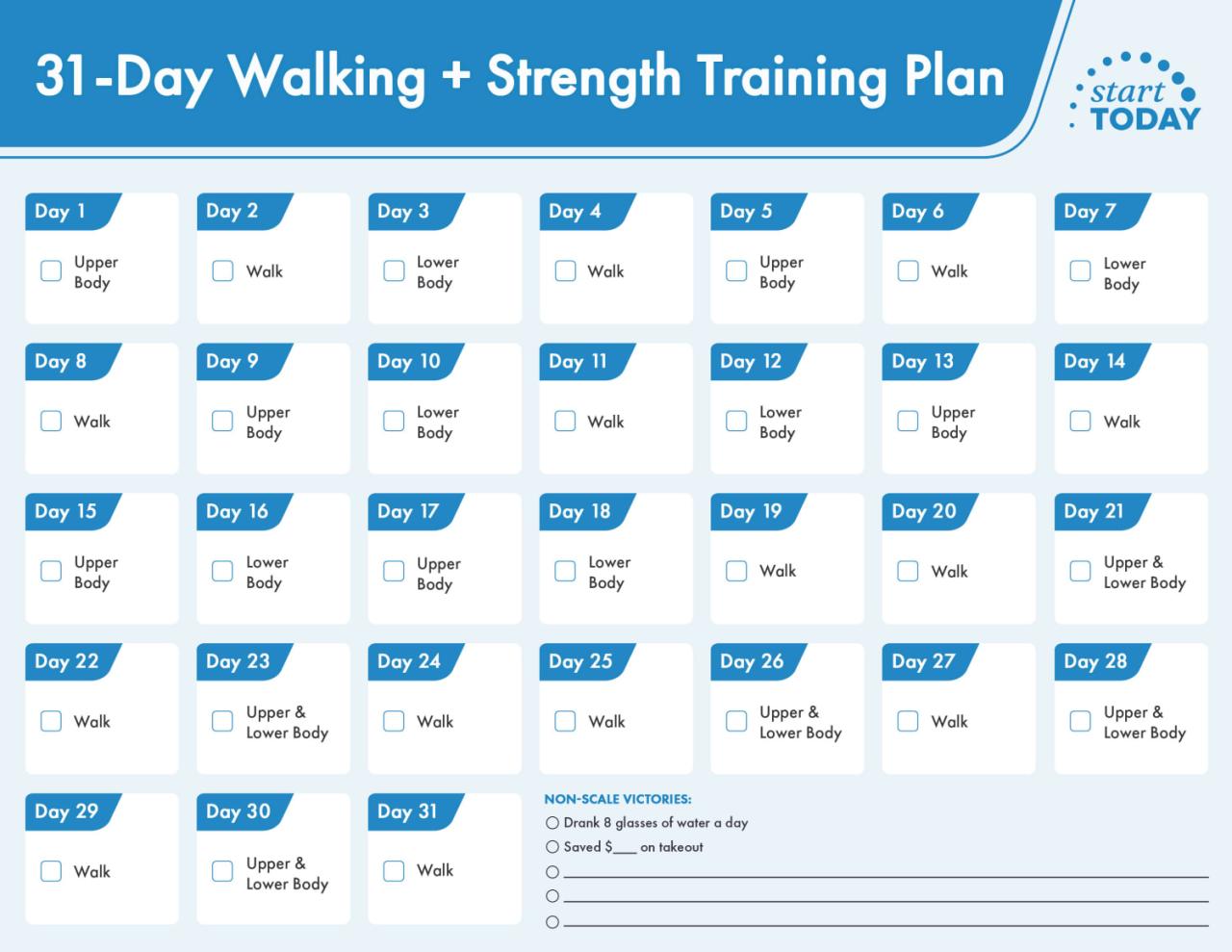
So, there you have it – your passport to a stronger, more sculpted you! Remember, consistency is key. Don’t be afraid to start small, celebrate your wins (big or small!), and always prioritize proper form over lifting heavier weights. Embrace the journey, and get ready to witness the incredible transformation you’re capable of. Now go forth and conquer those weights!
